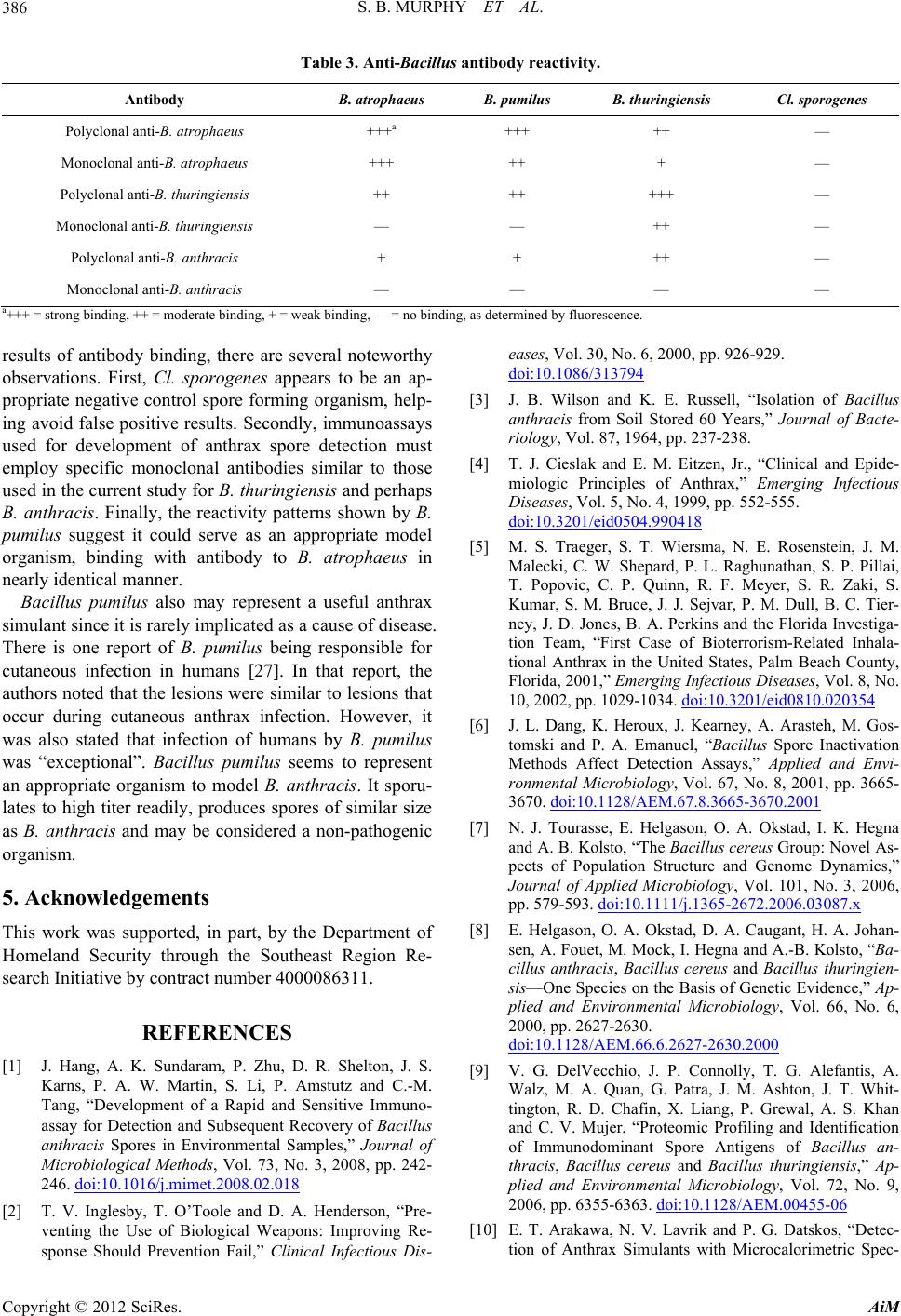
S. B. MURPHY ET AL.
386
Table 3. Anti-Bacillus antibody reactivity.
Antibody B. atrophaeus B. pumilus B. thuringiensis Cl. sporogenes
Polyclonal anti-B. atrophaeus +++a +++ ++ —
Monoclonal anti-B. atrophaeus +++ ++ + —
Polyclonal anti-B. thuringiensis ++ ++ +++ —
Monoclonal anti-B. thuringiensis — — ++ —
Polyclonal anti-B. anthracis + + ++ —
Monoclonal anti-B. anthracis — — — —
a+++ = strong binding, ++ = moderate binding, + = weak binding, — = no binding, as determined by fluorescence.
results of antibody binding, there are several noteworthy
observations. First, Cl. sporogenes appears to be an ap-
propriate negative control spore forming organism, help-
ing avoid false positive results. Secondly, immunoassays
used for development of anthrax spore detection must
employ specific monoclonal antibodies similar to those
used in the current study for B. thuringiensis and perhaps
B. anthracis. Finally, the reactivity patterns shown by B.
pumilus suggest it could serve as an appropriate model
organism, binding with antibody to B. atrophaeus in
nearly identical manner.
Bacillus pumilus also may represent a useful anthrax
simulant since it is rarely implicated as a cause of disease.
There is one report of B. pumilus being responsible for
cutaneous infection in humans [27]. In that report, the
authors noted that the lesions were similar to lesions that
occur during cutaneous anthrax infection. However, it
was also stated that infection of humans by B. pumilus
was “exceptional”. Bacillus pumilus seems to represent
an appropriate organism to model B. anthracis. It sporu-
lates to high titer readily, produces spores of similar size
as B. anthracis and may be considered a non-pathogenic
organism.
5. Acknowledgements
This work was supported, in part, by the Department of
Homeland Security through the Southeast Region Re-
search Initiative by contract number 4000086311.
REFERENCES
[1] J. Hang, A. K. Sundaram, P. Zhu, D. R. Shelton, J. S.
Karns, P. A. W. Martin, S. Li, P. Amstutz and C.-M.
Tang, “Development of a Rapid and Sensitive Immuno-
assay for Detection and Subsequent Recovery of Bacillus
anthracis Spores in Environmental Samples,” Journal of
Microbiological Methods, Vol. 73, No. 3, 2008, pp. 242-
246. doi:10.1016/j.mimet.2008.02.018
[2] T. V. Inglesby, T. O’Toole and D. A. Henderson, “Pre-
venting the Use of Biological Weapons: Improving Re-
sponse Should Prevention Fail,” Clinical Infectious Dis-
eases, Vol. 30, No. 6, 2000, pp. 926-929.
doi:10.1086/313794
[3] J. B. Wilson and K. E. Russell, “Isolation of Bacillus
anthracis from Soil Stored 60 Years,” Journal of Bacte-
riology, Vol. 87, 1964, pp. 237-238.
[4] T. J. Cieslak and E. M. Eitzen, Jr., “Clinical and Epide-
miologic Principles of Anthrax,” Emerging Infectious
Diseases, Vol. 5, No. 4, 1999, pp. 552-555.
doi:10.3201/eid0504.990418
[5] M. S. Traeger, S. T. Wiersma, N. E. Rosenstein, J. M.
Malecki, C. W. Shepard, P. L. Raghunathan, S. P. Pillai,
T. Popovic, C. P. Quinn, R. F. Meyer, S. R. Zaki, S.
Kumar, S. M. Bruce, J. J. Sejvar, P. M. Dull, B. C. Tier-
ney, J. D. Jones, B. A. Perkins and the Florida Investiga-
tion Team, “First Case of Bioterrorism-Related Inhala-
tional Anthrax in the United States, Palm Beach County,
Florida, 2001,” Emerging Infectious Diseases, Vol. 8, No.
10, 2002, pp. 1029-1034. doi:10.3201/eid0810.020354
[6] J. L. Dang, K. Heroux, J. Kearney, A. Arasteh, M. Gos-
tomski and P. A. Emanuel, “Bacillus Spore Inactivation
Methods Affect Detection Assays,” Applied and Envi-
ronmental Microbiology, Vol. 67, No. 8, 2001, pp. 3665-
3670. doi:10.1128/AEM.67.8.3665-3670.2001
[7] N. J. Tourasse, E. Helgason, O. A. Okstad, I. K. Hegna
and A. B. Kolsto, “The Bacillus cereus Group: Novel As-
pects of Population Structure and Genome Dynamics,”
Journal of Applied Microbiology, Vol. 101, No. 3, 2006,
pp. 579-593. doi:10.1111/j.1365-2672.2006.03087.x
[8] E. Helgason, O. A. Okstad, D. A. Caugant, H. A. Johan-
sen, A. Fouet, M. Mock, I. Hegna and A.-B. Kolsto, “Ba-
cillus anthracis, Bacillus cereus and Bacillus thuringien-
sis—One Species on the Basis of Genetic Evidence,” Ap-
plied and Environmental Microbiology, Vol. 66, No. 6,
2000, pp. 2627-2630.
doi:10.1128/AEM.66.6.2627-2630.2000
[9] V. G. DelVecchio, J. P. Connolly, T. G. Alefantis, A.
Walz, M. A. Quan, G. Patra, J. M. Ashton, J. T. Whit-
tington, R. D. Chafin, X. Liang, P. Grewal, A. S. Khan
and C. V. Mujer, “Proteomic Profiling and Identification
of Immunodominant Spore Antigens of Bacillus an-
thracis, Bacillus cereus and Bacillus thuringiensis,” Ap-
plied and Environmental Microbiology, Vol. 72, No. 9,
2006, pp. 6355-6363. doi:10.1128/AEM.00455-06
[10] E. T. Arakawa, N. V. Lavrik and P. G. Datskos, “Detec-
tion of Anthrax Simulants with Microcalorimetric Spec-
Copyright © 2012 SciRes. AiM